General Aspects and Applications of Juazeiro (Ziziphus joazeiro Mart.): Bioactive Compounds, Antioxidant Activity, and Antimicrobial Potential
Abstract
1. Introduction
2. Bibliographic Analysis
2.1. Origin and Botanical and Ecological Aspects of the Juazeiro
2.2. Scientific Publication Trends on Ziziphus joazeiro Mart.
2.3. Uses and Potential Applications of Parts of the Juazeiro
2.4. Bioactive Compounds and Antioxidant Activity
Extraction Technologies for Bioactives
2.5. Antimicrobial Activity
2.6. Fruit of Juazeiro
2.6.1. Physical Characteristics
2.6.2. Physicochemical Characteristics and Nutritional Profile
3. Conclusions
Author Contributions
Funding
Data Availability Statement
Conflicts of Interest
References
- do Nascimento, A.M.; da Fonseca, T.S.; Campos, M.F.; Moreira, L.O.; Marques, C.A.; Tavares, E.S.; Mendonça, S.C.; Leitão, G.G.; Simas, R.C.; Leitão, S.G. Ziziphus joazeiro, a Saponin-Rich Brazilian Medicinal Plant: Pharmacognostic Characterization of Bark and Leaves. Rev. Bras. Farmacogn. 2020, 30, 756–764. [Google Scholar] [CrossRef]
- Leite, G.Q.; de Andrade, F.H.D.; Macedo, R.O. Ziziphus joazeiro Mart.: UV–Vis quantification of saponin content in early growth stages with adult specimen correlation. Braz. J. Bot. 2022, 45, 1199–1207. [Google Scholar] [CrossRef]
- Oliveira, P.M.L.; Dantas, A.M.; dos Santos Morais, A.R.; Gibbert, L.; Krüger, C.C.H.; dos Santos Lima, M.; Borges, G.D.S.C. Fruto Juá (Ziziphus joazeiro) da Caatinga: Fonte de fibra alimentar e flavonóides bioacessíveis. Pesqui. Aliment. Int. 2020, 129, 108745. [Google Scholar]
- Andradea, J.C.; dos Santos, A.T.L.; da Silvaa, A.R.P.; Freitasa, M.A.; Gonçalob, M.I.P.; do Socorro Costa, M.; Coutinhoa, H.D.M. Caracterização fitoquímica de metabólitos de ziziphus joazeiro mart. por uplc-qtof e avaliação da atividade antifúngica. In Avaliação de Bioatividades e da Ação dos Extratos; Universidade Regional do Cariri: Juazeiro do Norte, Brazil, 2019; p. 84. [Google Scholar]
- Silva, J.; de Fátima Moura, M.; Silva, T.; Araújo, N.; Barbosa, I. Caracterização físico-química e composição centesimal e mineral do fruto do juazeiro (Ziziphus joazeiro Mart.). Enciclopédia Biosf. 2017, 14, 291. [Google Scholar]
- Brito, S.M.; Coutinho, H.D.; Talvani, A.; Coronel, C.; Barbosa, A.G.; Vega, C.; Menezes, I.R. Atividade gastroprotetora e cicatrizante do Ziziphus joazeiro Mart. extrato hidroalcoólico de folhas. J. Fisiol. Farmacol. 2020, 71, 429–436. [Google Scholar]
- Mauro, A.C.; Ribeiro, B.D.; Garrett, R.; Borges, R.M.; da Silva, T.U.; de Paula Machado, S.; de Araújo, J.R.; Masafra, S.d.O.; de Oliveira Junior, F.O.R.; D’Elia, E. Ziziphus joazeiro stem bark extract as a green corrosion inhibitor for mild steel in acid medium. Processes 2021, 9, 1323. [Google Scholar] [CrossRef]
- Barros, N.N.; Freire, L.C.L.; Lopes, E.A.; Johnson, W.L. Valor nutritivo do feno de juazeiro (Zizyphus joazeiro) para caprinos e ovinos. Pesqui. Agropecu. Bras. 1991, 26, 1299–1304. [Google Scholar]
- Dantas, F.C.P.; Tavares, M.L.R.; da Silva Targino, M.; da Costa, A.P.; Dantas, F.O. Ziziphus joazeiro Mart.-Rhamnaceae: Características biogeoquímicas e importância no bioma Caatinga. Rev. Principia 2014, 25, 51–57. [Google Scholar] [CrossRef]
- Macêdo, L.F. Farinha do Fruto do Ziziphus Joazeiro Mart. Obtida POR Secagem em Camada de Espuma; Trabalho de Conclusão de Curso, Cinências Agrárias, Universidade Federal de Campina Grande: Campina Grande, Brazil, 2022; p. 40. [Google Scholar]
- Rocha, T.S.; de Lima, A.; Silva, J.D.N.; Sampaio, G.R.; Soares Freitas, R.A.M.; Danielski, R.; Camargo, A.C.; Shahidi, F.; Torres, E.A.F.D.S. Vitamin c and phenolic antioxidants of jua (Ziziphus joazeiro m.) pulp: A rich underexplored Brazilian source of ellagic acid recovered by aqueous ultrasound-assisted extraction. Molecules 2022, 27, 627. [Google Scholar] [CrossRef]
- Costa, J.D.D.S.; DA Silva, J.A.B.; Coelho, D.S.; Santos, Í.E.D.A.; Seabra, T.X. Methods for overcoming seed dormancy and the initial growth of Ziziphus joazeiro Mart. in different soils. Rev. Caatinga 2016, 29, 441–449. [Google Scholar] [CrossRef]
- Duarte, M.M.; Nogueira, A.C.; Vieira, E.S.N. Diversity and spatial genetic structure of natural populations of Ziziphus joazeiro Mart. Rev. Bras. Ciênc. Agrárias 2018, 13, 16. [Google Scholar] [CrossRef]
- de Azevedo, D.V.; Silva, D.M.; Magalhães, F.E.A.; de Araújo, J.I.F.; de Araujo, S.M.B.; da Silva Lopes, F.F.; de Moraes, S.M.; Batista, F.L.A.; Moura, L.F.W.G.; Guedes, M.I.F. Evaluation of antioxidant, toxicological and anxiolytic-like effect of ethanolic extracts of Ziziphus cotinifolia Reissek in adult zebrafish (Danio rerio). Phytomed. Plus 2024, 4, 100504. [Google Scholar] [CrossRef]
- Silva, A.R.P.; do Socorro Costa, M.; Araújo, N.J.S.; Alencar, G.G.; Ribeiro, P.R.V.; Tavares, J.F.; Pinheiro, J.C.A.; Coutinho, H.D.M. UPLC-QTOF-MS/MS characterization of a fraction enriched in saponins from Sarcomphalus joazeiro species and evalua-tion of the antibacterial activity against multidrug-resistant bacteria. S. Afr. J. Bot. 2024, 165, 324–330. [Google Scholar] [CrossRef]
- Cavalcanti, M.T.; Silveira, D.C.; Florêncio, I.M.; Feitosa, A.A.; Eller, S.C.W.d.S. Obtenção da farinha do fruto do juazeiro, Ziziphus joazeiro Mart., e caracterização físico-química. Rev. Verde Agroecol. Desenvolv. Sustent. 2011, 6, 42. [Google Scholar]
- Fernandes, F.G.; Silva, R.D.S.; Oliveira, P.M.D.L.; Petkowicz, C.L.D.O.; Borges, G.D.S.C. Microwave-assisted extraction of mucilage from juá: Characterization and antioxidant activity. J. Food Sci. 2024, 89, 4430–4439. [Google Scholar] [CrossRef]
- Nadia, T.D.L.; Machado, I.C.; Lopes, A.V. Fenologia reprodutiva e sistema de polinização de Ziziphus joazeiro Mart. (Rhamnaceae): Atuação de Apis mellifera e de visitantes florais autóctones como polinizadores. Acta Bot. Bras. 2007, 21, 835–845. [Google Scholar] [CrossRef]
- Silva, H.A.; Gomes, J.P.; de Melo Queiroz, A.J. Comportamento higroscópico e propriedades termodinâmicas da farinha de grão de Ziziphus joazeiro Mart. J. Agric. Stud. 2020, 8, 50–62. [Google Scholar]
- Silva, R.d.S.; Fernandes, F.G.; Dantas, A.M.; de Carvalho, L.M.; da Costa, W.K.A.; dos Santos Lima, M.; Magnani, M.; Borges, G.D.S.C. Juá (Ziziphus joazeiro Mart.) mucilage and juá by-product phenolic extract improve quality parameters and retain bioactive compounds in fresh-cut pineapple during storage. Food Res. Int. 2022, 161, 111826. [Google Scholar] [CrossRef]
- Leandro, G.R.; de Souza, O.F.; Medeiros, T.K.F.; de Oliveira, J.P.F. Qualidade e segurança do queijo coalho utilizando um novo revestimento comestível à base de polpa do fruto Ziziphus joazeiro. Aliment. Futuro 2021, 4, 100089. [Google Scholar]
- Brito, S.M.; Coutinho, H.D.; Talvani, A.; Coronel, C.; Barbosa, A.G.; Vega, C.; Figueredo, F.G.; Tintino, S.R.; Lima, L.F.; Boligon, A.A.; et al. Analysis of bioactivities and chemical composition of Ziziphus joazeiro Mart. using HPLC–DAD. Food Chem. 2015, 186, 185–191. [Google Scholar] [CrossRef]
- Silva, T.C.L.; Almeida, C.C.B.R.; Veras Filho, J.; Sobrinho, T.P.; Amorim, E.L.C.; Costa, E.P.; Araújo, J.M. Atividades antioxidante e antimicrobiana de Ziziphus joazeiro mart. (Rhamnaceae): Avaliação comparativa entre cascas e folhas. Rev. Ciências Farm. Básica Apl. 2011, 32, 193–199. [Google Scholar]
- Guimarães, M.L.; da Silva, F.A.G., Jr.; da Costa, M.M.; de Oliveira, H.P. Green synthesis of silver nanoparticles using Ziziphus joazeiro leaf extract for production of antibacterial agents. Appl. Nanosci. 2020, 10, 1073–1081. [Google Scholar] [CrossRef]
- Andrade, J.C.; Silva, A.R.P.; Freitas, M.A.; Azevedo, R.B.; Freitas, T.S.; Franz, A.G.; Coutinho, H.D.M. Controle de biofilmes bacterianos e fúngicos por produtos naturais de Ziziphus joazeiro Mart. (Rhamnaceae). Imunol. Comp. Microbiol. Doenças Infecc. 2019, 65, 226–233. [Google Scholar] [CrossRef] [PubMed]
- Ribeiro, B.D.; Alviano, D.S.; Barreto, D.W.; Coelho, M.A.Z. Propriedades funcionais das saponinas do sisal (Agave sisalana) e do juá (Ziziphus joazeiro): Concentração micelar crítica, atividades antioxidante e antimicrobiana. Colóides Superfícies A Asp. Físico-Químicos Eng. 2013, 436, 736–743. [Google Scholar]
- Cruz, M.C.S.; Santos, P.O.; Barbosa, A.M., Jr.; De Mélo, D.L.F.M.; Alviano, C.S.; Antoniolli, A.R.; Alviano, D.S.; Trindade, R.C. Antifungal activity of Brazilian medicinal plants involved in popular treatment of mycoses. J. Ethnopharmacol. 2007, 111, 409–412. [Google Scholar] [CrossRef] [PubMed]
- Costa, T.; Jorge, N. Compostos Bioativos Benéficos Presentes em Castanhas e Nozes. J. Health Sci. 2011, 13, 195–203. [Google Scholar] [CrossRef]
- Ribeiro, J.N.; Ribeiro, A.V.F.N.; Monteiro, F.C.; Licinio, M.V.V.J.; Pereira, M.G. Study of the Ziziphus joazeiro peel for indigo blue adsorption. Int. J. Adv. Res. 2019, 7, 171–178. [Google Scholar] [CrossRef]
- Damodaran, S.; Parkin, K.L. Química de Alimentos de Fennema; Artmed: Bucuresti, Romania, 2018. [Google Scholar]
- Sousa, C.M.D.M.; Silva, H.R.; Vieira, G.M.; Ayres, M.C.C.; Costa, C.L.S.D.; Araújo, D.S.; Cavalcante, L.C.D.; Barros, E.D.S.; Araújo, P.B.D.M.; Brandão, M.S.; et al. Fenóis totais e atividade antioxidante de cinco plantas medicinais. Química Nova 2007, 30, 351–355. [Google Scholar] [CrossRef]
- Zhu, S.Y.; Li, N.; Liu, Z.H.; Yuan, Y.J.; Li, B.Z. Harnessing Aromatic Properties for Sustainable Bio-valorization of Lignin Derivatives into Flavonoids. Green Carbon 2025, 3, 172–195. [Google Scholar] [CrossRef]
- Melo, M.D.S.F.; Rocha, C.Q.; Santos, M.H.; Chavasco, J.M.; Chavasco, J.K. Pesquisa de bioativos com atividade antimicrobiana nos extratos hidroetanólicos do fruto, folha e casca de caule do Zizyphus joazeiro mart. Rev. Univ. Val. Rio Verde 2012, 10, 43–51. [Google Scholar] [CrossRef]
- Zhang, H.; Jiang, L.; Ye, S.; Ye, Y.; Ren, F. Systematic evaluation of antioxidant capacities of the ethanolic extract of different tissues of jujube (Ziziphus jujuba Mill.) from China. Food Chem. Toxicol. 2010, 48, 1461–1465. [Google Scholar] [CrossRef] [PubMed]
- Gao, Q.H.; Wu, C.S.; Wang, M.; Xu, B.N.; Du, L.J. Effect of Drying of Jujubes (Ziziphus jujuba Mill.) on the Contents of Sugars, Organic Acids, α-Tocopherol, β-Carotene, and Phenolic Compounds. J. Agric. Food Chem. 2012, 60, 9642–9648. [Google Scholar] [CrossRef]
- Wojdyło, A.; Carbonell-Barrachina, Á.A.; Legua, P.; Hernández, F. Phenolic composition, ascorbic acid content, and antioxidant capacity of Spanish jujube (Ziziphus jujube Mill.) fruits. Food Chem. 2016, 201, 307–314. [Google Scholar] [CrossRef]
- Gomes, D.C.; de Lima, H.G.; Vaz, A.V.; Santos, N.S.; Santos, F.O.; Dias, Ê.R.; Botura, M.B.; Branco, A.; Batatinha, M.J.M. Atividade anti-helmíntica in vitro da casca de Zizyphus joazeiro contra nematóides gastrointestinais de cabras e sua citotoxicidade em células Vero. Vet. Parasitol. 2016, 15, 10–16. [Google Scholar] [CrossRef] [PubMed]
- Fonseca, F.C.S.; Reis, L.C.B.; Dos Santos, J.D.G.; Branco, C.R.C.; da Costa Ferreira, S.L.; David, J.M.; Branco, A. Betulinic acid from Zizyphus joazeiro bark using focused microwave-assisted extraction and response surface methodology. Pharmacogn. Mag. 2017, 13, 226. [Google Scholar] [CrossRef]
- Schühly, W.; Heilmann, J.; Çalis, I.; Sticher, O. New triterpenoids with antibacterial activity from Zizyphus joazeiro. Planta Medica 1999, 65, 740–743. [Google Scholar] [CrossRef]
- de Carvalho, N.K.G.; Leite, D.O.D.; Colares, A.V.; Souza, F.A.; Calabrese, K.d.S.; Salazar, G.J.T.; Nascimento, J.B.D.; da Silva, M.P.; Rodrigues, F.F.G.; da Costa, J.G.M. Quantification of Phenolic Compounds by HPLC/DAD and Evaluation of the Antioxidant, Antileishmanial, and Cytotoxic Activities of Ethanolic Extracts from the Leaves and Bark of Sarcomphalus joazeiro (Mart.). Plants 2025, 14, 1733. [Google Scholar] [CrossRef] [PubMed]
- Ribeiro, B.D.; Barreto, D.W.; Coelho, M.A.Z. Recovery of saponins from Jua (Ziziphus joazeiro) by micellar extraction and cloud Point preconcentration. J. Surfactants Deterg. 2014, 17, 553–561. [Google Scholar] [CrossRef]
- dos Santos, C.H.C.; de Carvalho, M.G.; Laub, A.; Franke, K.; Wessjohann, L. UHPLC-ESI-Orbitrap-HR-MS analysis of cyclopeptide alkaloids from Ziziphus joazeiro. Nat. Prod. Commun. 2021, 16, 1934578X211054955. [Google Scholar] [CrossRef]
- Andrade, J.C.; da Silva, A.R.P.; dos Santos, A.T.L.; Freitas, M.A.; de Matos, Y.M.L.; Braga, M.F.B.M.; Bezerra, C.F.; Gonçalo, M.I.P.P.; Gomez, M.C.V.V.; Rolóm, M.; et al. Chemical composition, antiparasitic and cytotoxic activities of aqueous extracts of Ziziphus joazeiro Mart. Asian Pac. J. Trop. Biomed. 2019, 9, 222–226. [Google Scholar] [CrossRef]
- Torres-Ortiz, D.; García-Alcocer, G.; Berumen-Segura, L.C.; Estévez, M. Extração verde de metabólitos secundários de plantas: Obstáculos, situação atual e tendências. Quím. Sustent. Para Meio Ambiente 2024, 8, 100157. [Google Scholar]
- Chemat, F.; Abert-Vian, M.; Fabiano-Tixier, A.S.; Strube, J.; Uhlenbrock, L.; Gunjevic, V.; Cravotto, G. Green extraction of natural products. Origins, current status, and future challenges. TrAC Trends Anal. Chem. 2019, 118, 248–263. [Google Scholar] [CrossRef]
- Myo, H.; Buathong, N.; Saelee, M.; Saewan, N.; Khat-Udomkiri, N. Enhancement of bioactive compound extraction from Rhus chinensis leaves using the polyol-based ultrasound-assisted method: Antioxidant, anti-melanogenesis, and pollution defense properties. Ind. Crops Prod. 2025, 233, 121414. [Google Scholar] [CrossRef]
- Amador-Luna, V.M.; Montero, L.; Pajuelo, C.; Ibáñez, E.; Herrero, M. Comparison of different methods for the removal of natural deep eutectic solvents after gas-expanded liquids extraction of bioactive compounds from orange by-products. Sep. Purif. Technol. 2025, 374, 133755. [Google Scholar] [CrossRef]
- Alviano, W.S.; Alviano, D.S.; Diniz, C.G.; Antoniolli, A.R.; Alviano, C.S.; Farias, L.M.; Bolognese, A.M. Potencial antioxidante in vitro de extratos de plantas medicinais e suas atividades contra bactérias orais baseadas na medicina popular brasileira. Arq. De Biol. Oral 2008, 53, 545–552. [Google Scholar] [CrossRef]
- Fernandes, P.R.D.; Bizerra, A.M.C. Avaliação quantitativa de atividades antioxidantes das plantas nativas da Região do Alto Oeste Potiguar/RN. Res. Soc. Dev. 2020, 9, 76. [Google Scholar] [CrossRef]
- Almeida, O.J.I.; Costa, F.; Paulino, C.G.; de Oliveira Almeida, M.J.; Damaceno, M.N.; dos Santos, S.M.L.; de Farias, V.L. Efeito da pasteurização sobre os compostos bioativos e a atividade antioxidante de polpa de frutos de Ziziphus joazeiro Mart. Res. Soc. Dev. 2020, 9, e135953245. [Google Scholar] [CrossRef]
- Gao, Q.H.; Wu, P.T.; Liu, J.R.; Wu, C.S.; Pary, J.W.; Wang, M. Physicochemical properties and antioxidant capacity of different jujube (Ziziphus jujuba Mill.) cultivars grown in loess plateau of China. Scientia Horticulturae. 2011, 130, 67–72. [Google Scholar] [CrossRef]
- Herrero, M.; Castro-Puyana, M.; Mendiola, J.A.; Ibanez, E. Compressed fluids for the extraction of bioactive compounds. TrAC Trends Anal. Chem. 2013, 43, 67–83. [Google Scholar] [CrossRef]
- Chitarra, M.I.F.; Chitarra, A.B. Pós-Colheita de Frutos e Hortaliças: Fisiologia e Manuseio; ESAL/FAEPE: Lavras, Brazil, 2005; Volume 785. [Google Scholar]
- Freitas, J.I.B.; Leite, R.P.; Altino, A.L.G.; Nunes, L.C.T.; Almeida-Bezerra, J.W.; Assis, J.C.L.; Santos, M.A.F.; Maia Filho, A.; Bezerra, J.S.; Souza, D.L.; et al. Phytochemical profile and evaluation of the antimicrobial efficacy of Ziziphus joazeiro Mart. powder extract. on the control of biofilm and tooth decay. Contrib. A Las Cienc. Soc. 2024, 17, 1–18. [Google Scholar]
- da Silva, J.L.; da Costa, F.B.; Nascimento, A.M.D.; Costa, R.T.R.D.V.; Formiga, A.D.S. Pós-colheita de frutos de juazeiro em diferentes estádios de maturação. Rev. Verde Agroecol. Desenvolv. Sustentável 2018, 13, 302–307. [Google Scholar] [CrossRef]
- Coelho, E.L.; Fontes, P.C.R.; Finger, F.L.; Cardoso, A.A. Qualidade de fruto de melão rendilhado em função de doses de nitrogênio. Bragantia 2003, 62, 173–178. [Google Scholar] [CrossRef]
- Silva, J.L.D. Qualidade e Armazenamento de Frutos de Juazeiro (Ziziphus joazeiro Mart.) Sob Temperatura Ambiente; Universidade Federal de Campina Grande: Campina Grande, Brazil, 2015. [Google Scholar]
- Soares, B.E.A.S.; Benício, V.C.; dos Santos Souza, H.M.; Garcia, E.I.; Mendes, M.L.M.; de Omena Messias, C.M.B. Caracterização físico-química de doce cremoso funcional do fruto do juazeiro (Ziziphus joazeiro Mart.). Res. Soc. Dev. 2022, 11, 9. [Google Scholar] [CrossRef]
- Diniz, V.M. Processamento do Fruto do Juazeiro Para Obtenção da Farinha e do Óleo; Universidade Federal de Campina Grande: Campina Grande, Brazil, 2016. [Google Scholar]
- Tresena, N.D.L. Processo de Biofermentação da Polpa de Juá e Reaproveitamento do Subproduto Para Alimentação; Universidade Federal de Campina Grande: Campina Grande, Brazil, 2019. [Google Scholar]
- Sousa, F.C.; de Melo Silva, L.M.; de Castro, D.S.; Nunes, J.S.; de Sousa, E.P. Propriedades físicas e físico-químicas da polpa de juazeiro. Rev. Verde Agroecol. Desenvolv. Sustent. 2013, 8, 10. [Google Scholar]
- Fregonesi, J.A.; Veira, D.M.; Von Keyserlingk, M.A.G.; Weary, D.M. Efeitos da qualidade da cama no comportamento de deitar de vacas leiteiras. J. Dairy Sci. 2007, 90, 5468–5472. [Google Scholar] [CrossRef] [PubMed]
- Almansa, S.; Hernández, F.; Legua, P.; Nicolás-Almansa, M.; Amorós, A. Alterações físico-químicas e fisiológicas durante o desenvolvimento dos frutos e amadurecimento na árvore de duas cultivares de jujuba espanhola (Ziziphus jujuba Mill.). Rev. Ciênc. Aliment. Agric. 2016, 96, 4098–4105. [Google Scholar]
- Gao, Q.H.; Wu, C.S.; Wang, M. The jujube (Ziziphus jujuba Mill.) fruit: A review of current knowledge of fruit composition and health benefits. J. Agric. Food Chem. 2013, 61, 3351–3363. [Google Scholar] [CrossRef]
- Lago-Vanzela, E.S.; Ramin, P.; Umsza-Guez, M.A.; Santos, G.V.; Gomes, E.; Silva, R.D. Chemical and sensory characteristics of pulp and peel’cajá-manga’(Spondias cytherea Sonn.) jelly. Food Sci. Technol. 2011, 31, 398–405. [Google Scholar] [CrossRef]
- Gava, A.J.; Silva, C.A.B.d.a.; Frias, J.G. Tecnologia de Alimentos: Princípios Aplicações; Nobel: São Paulo, Brazil, 2008; Volume 98. [Google Scholar]
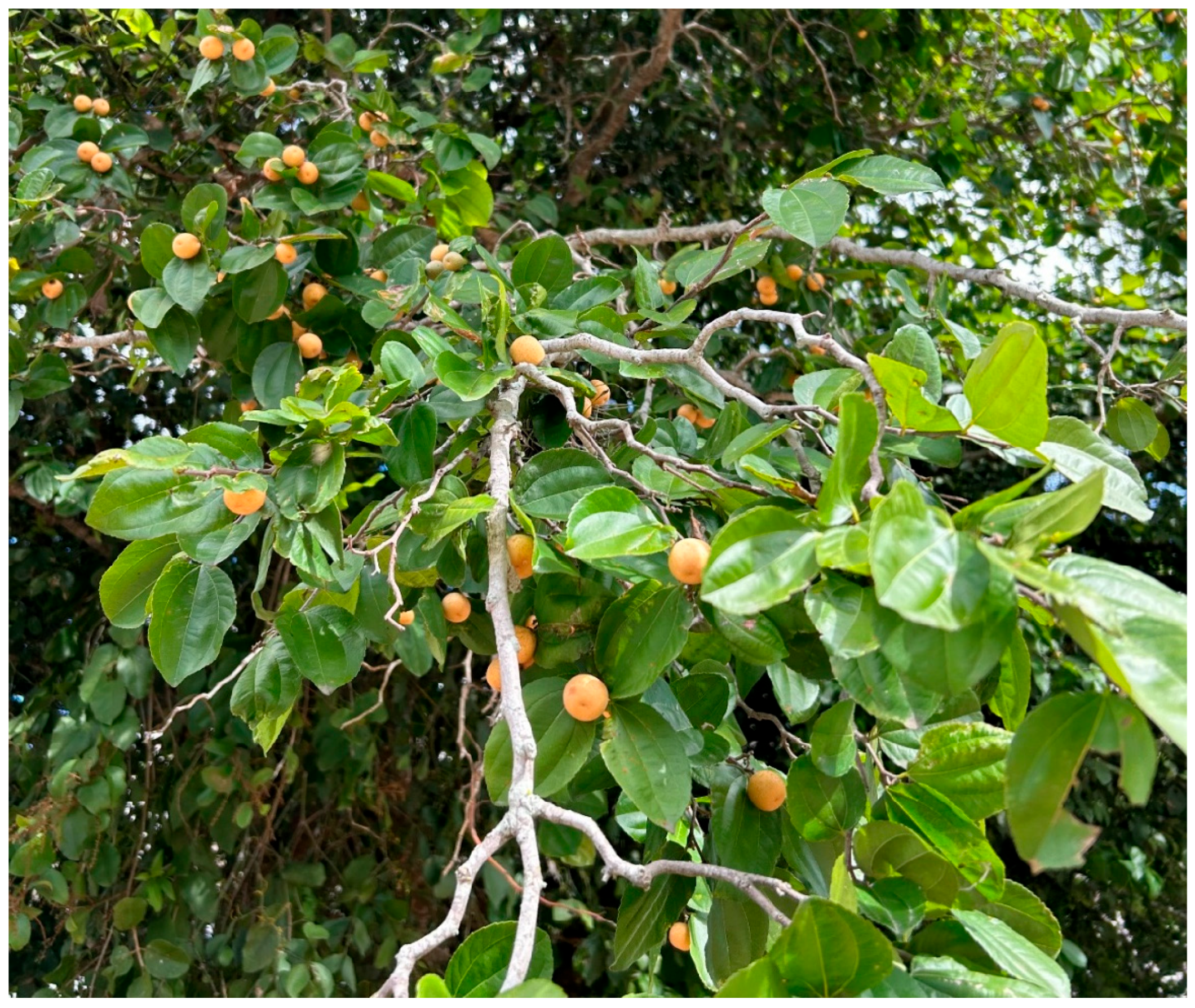
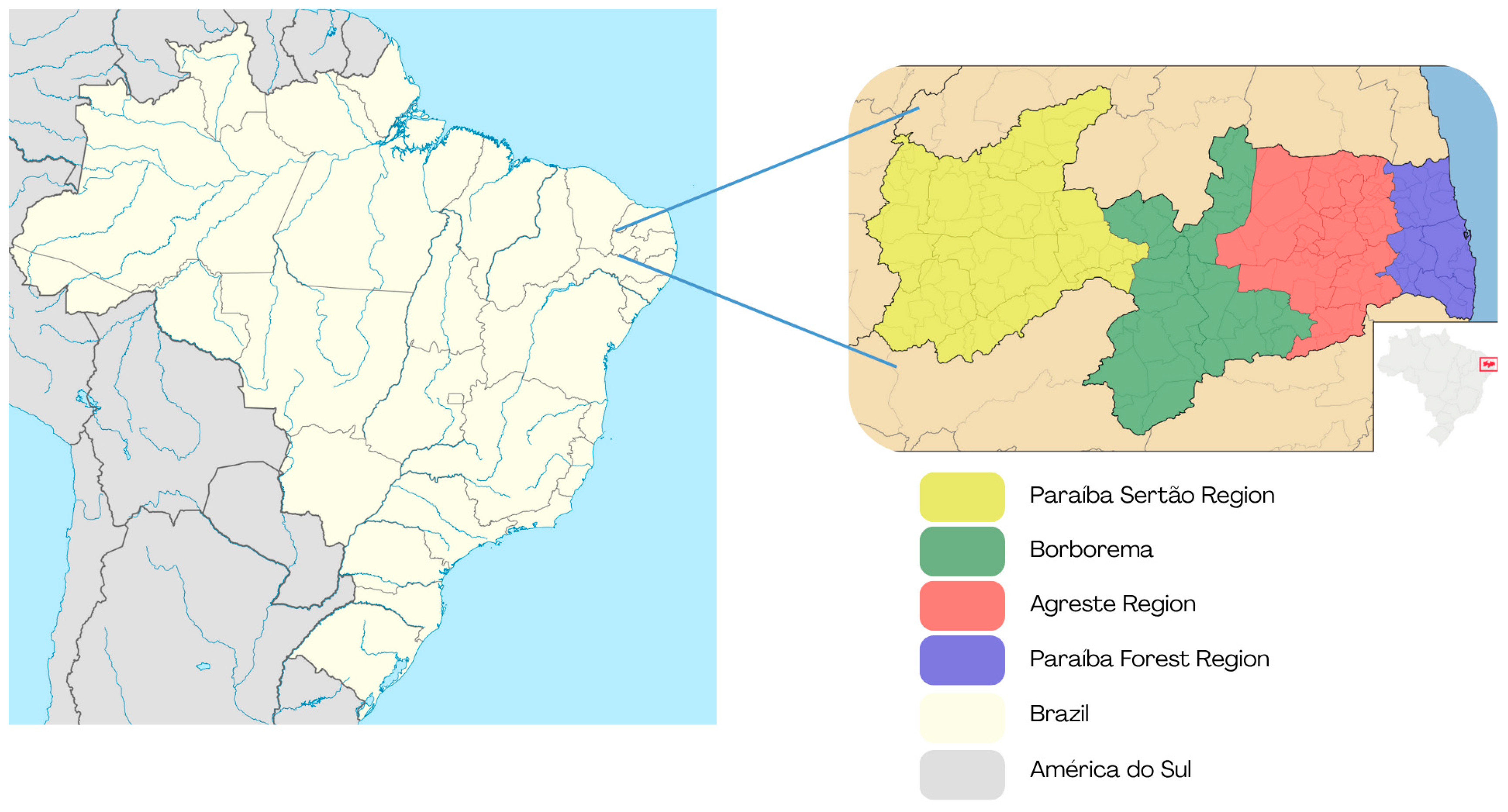
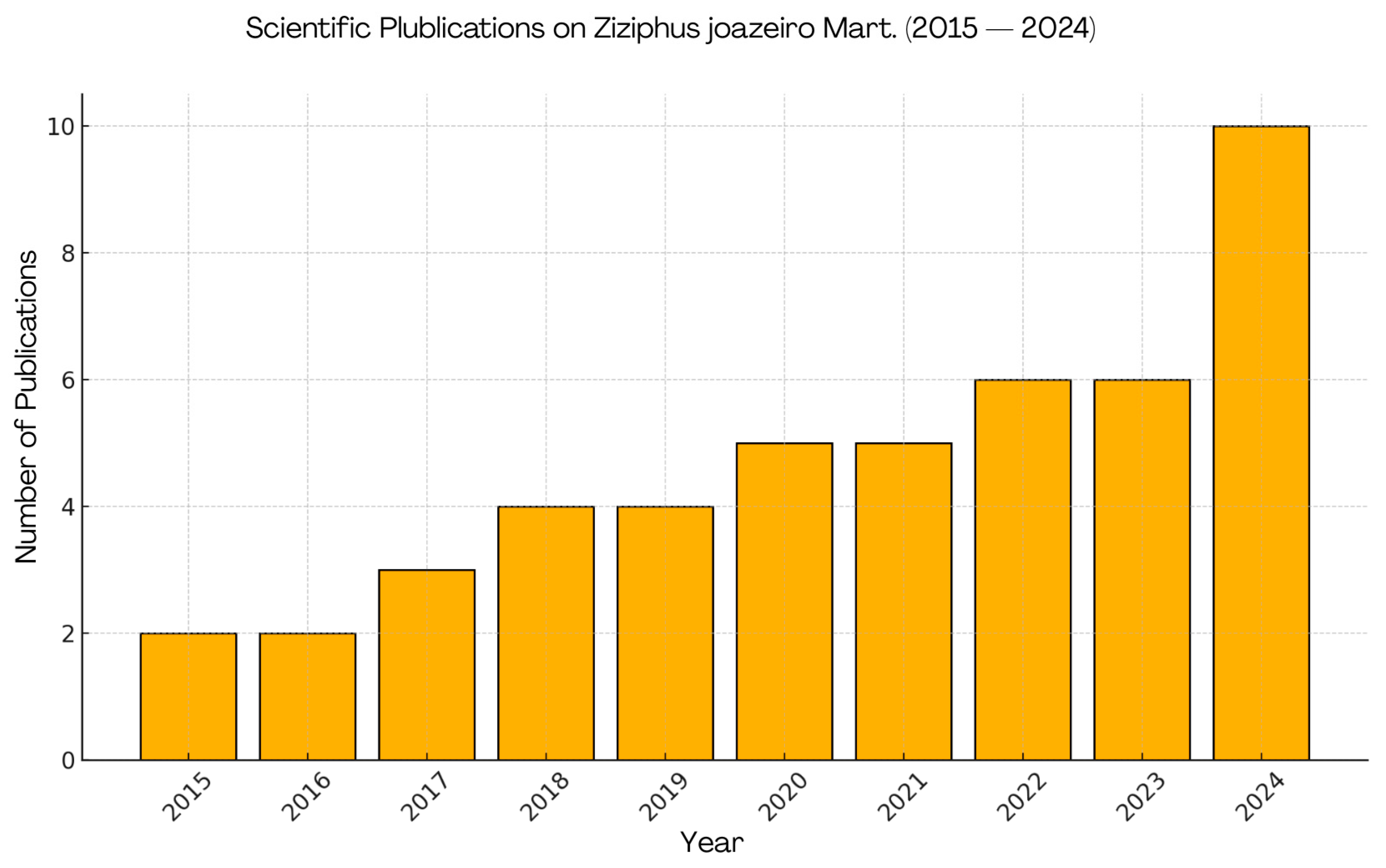
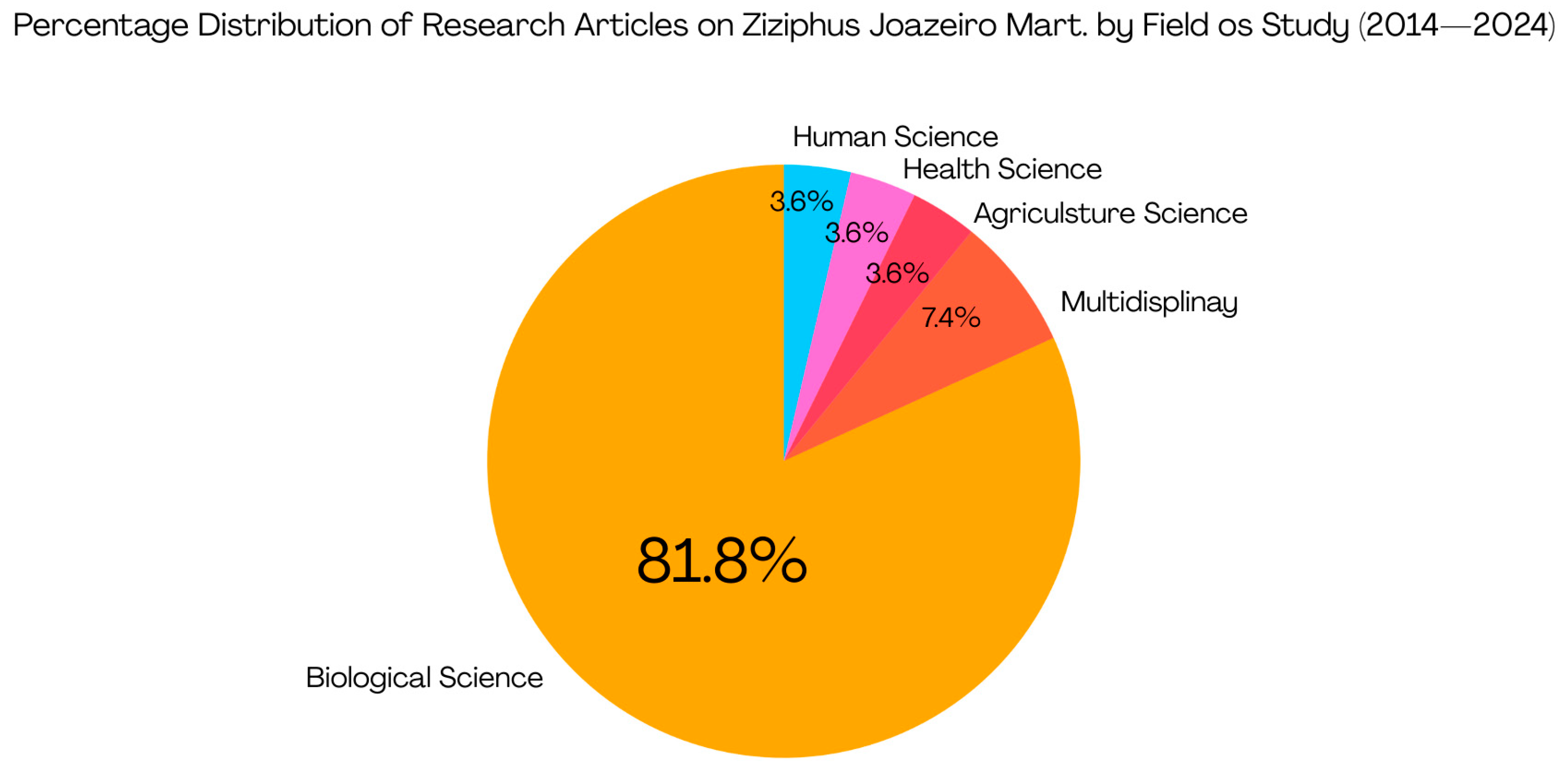
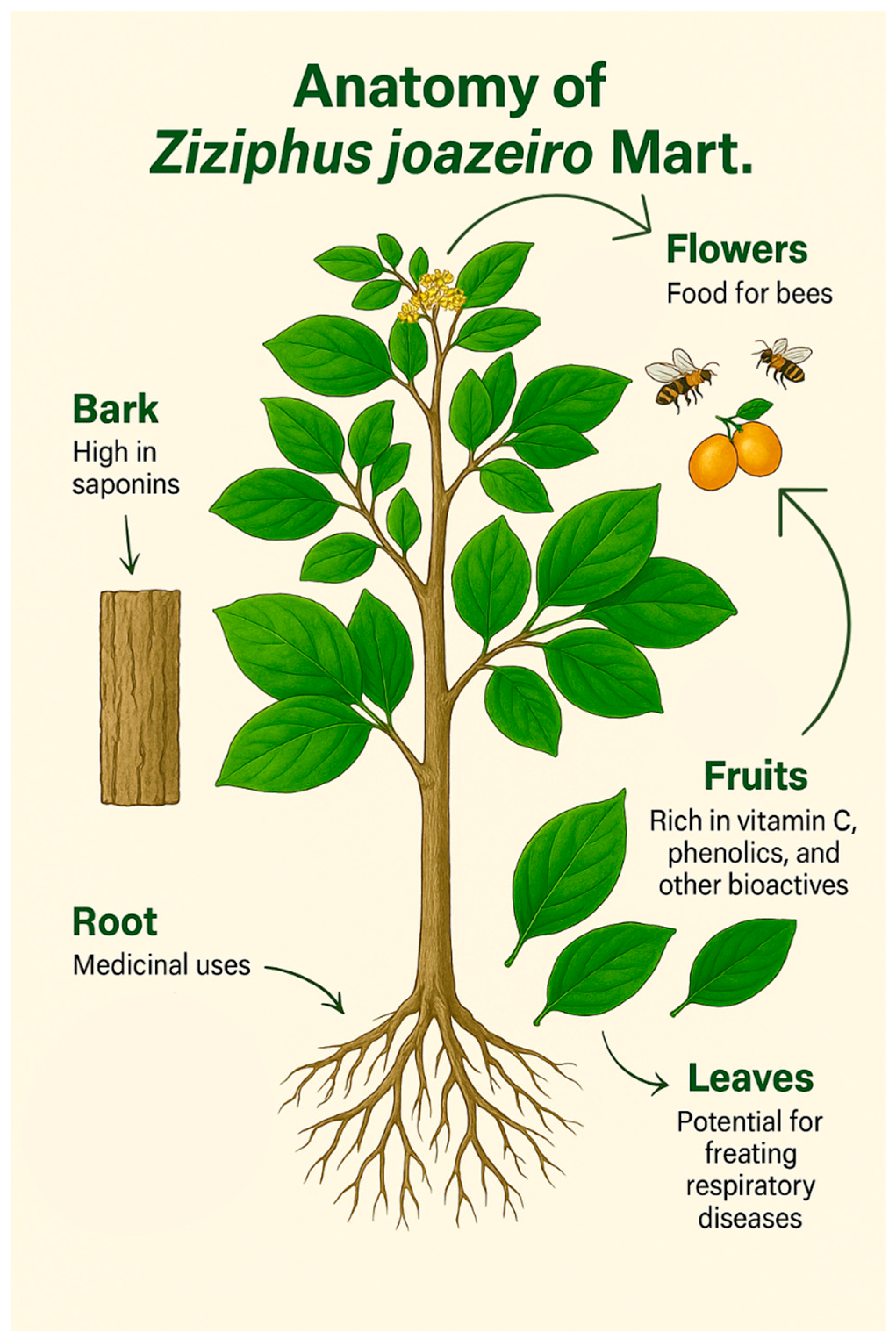
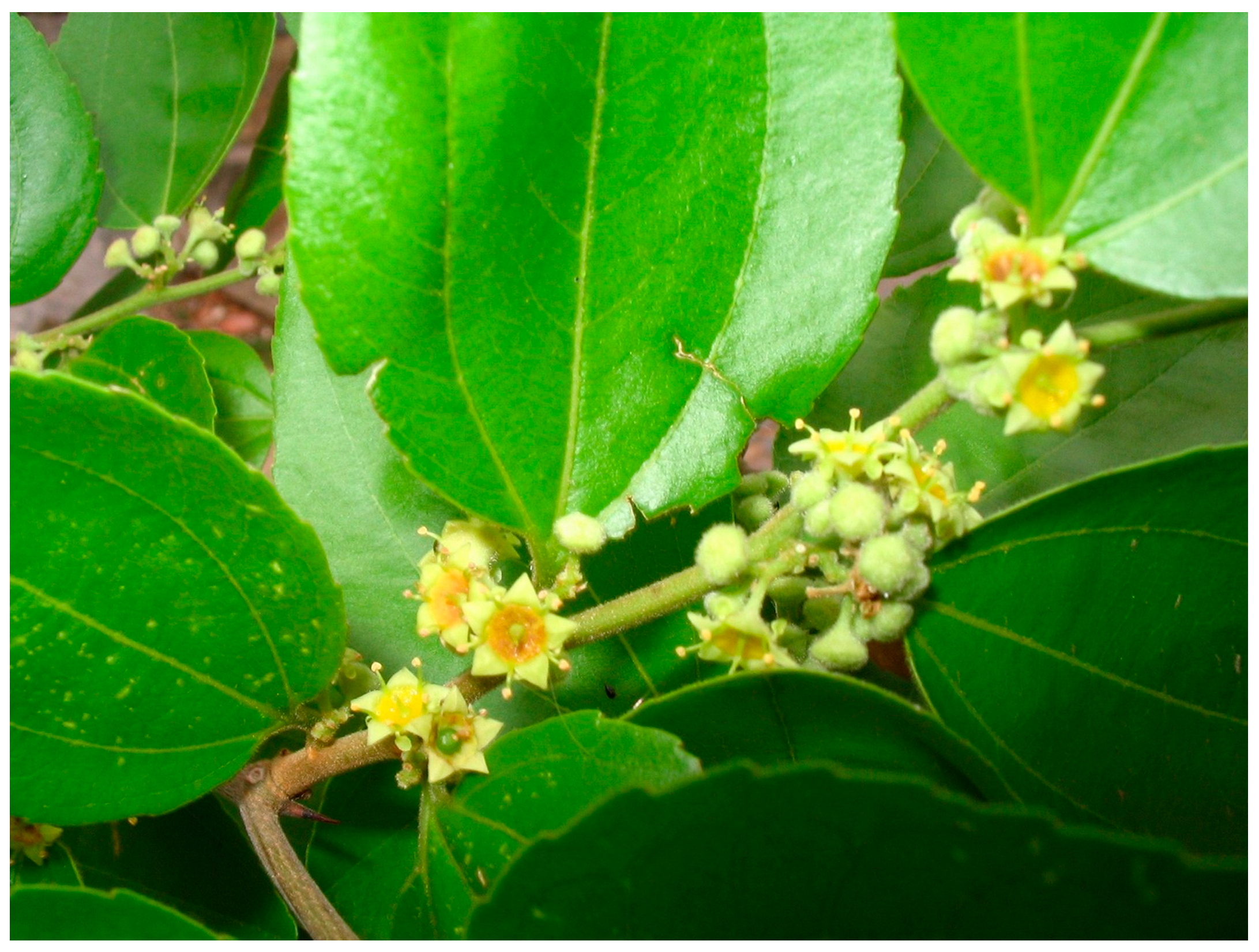

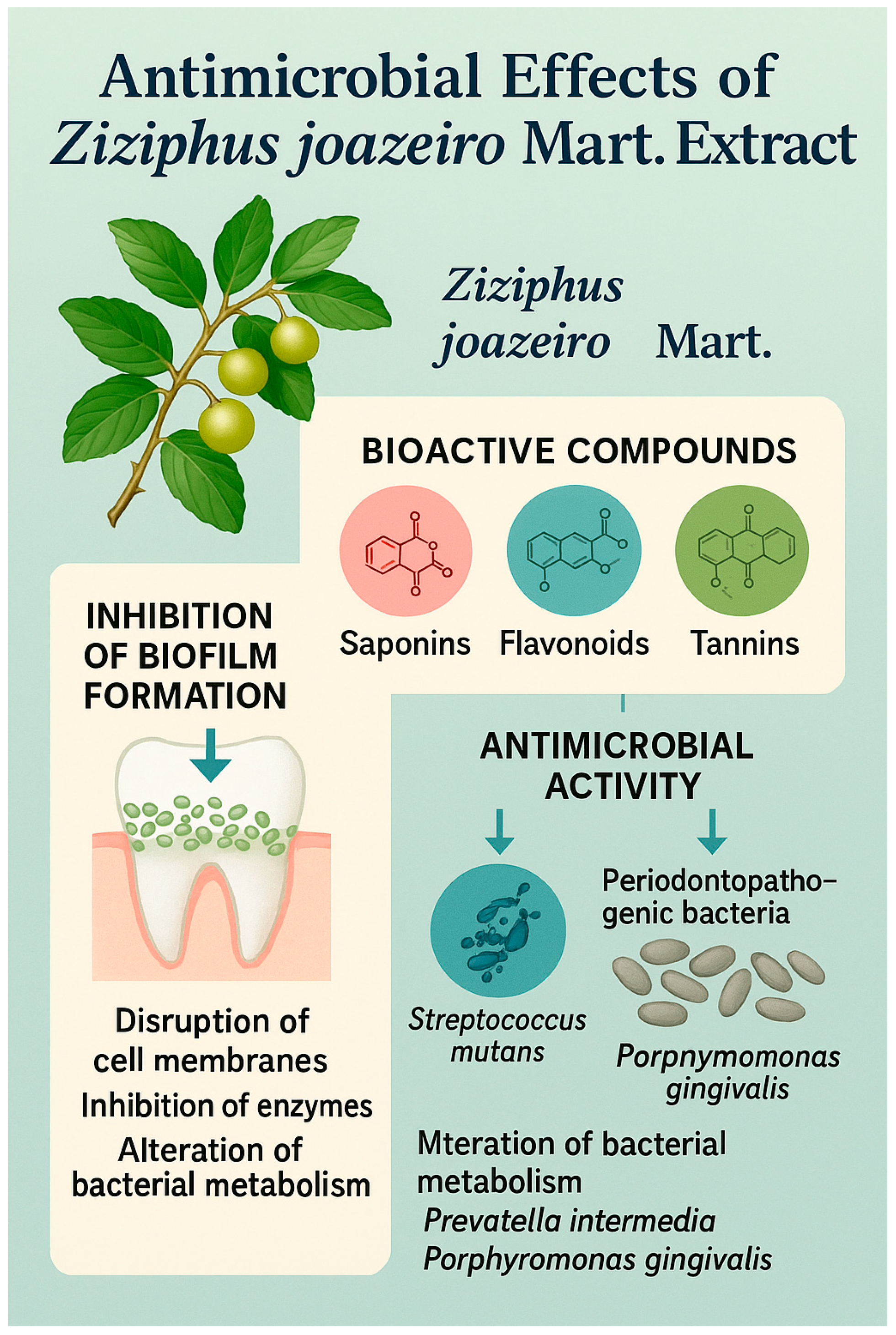
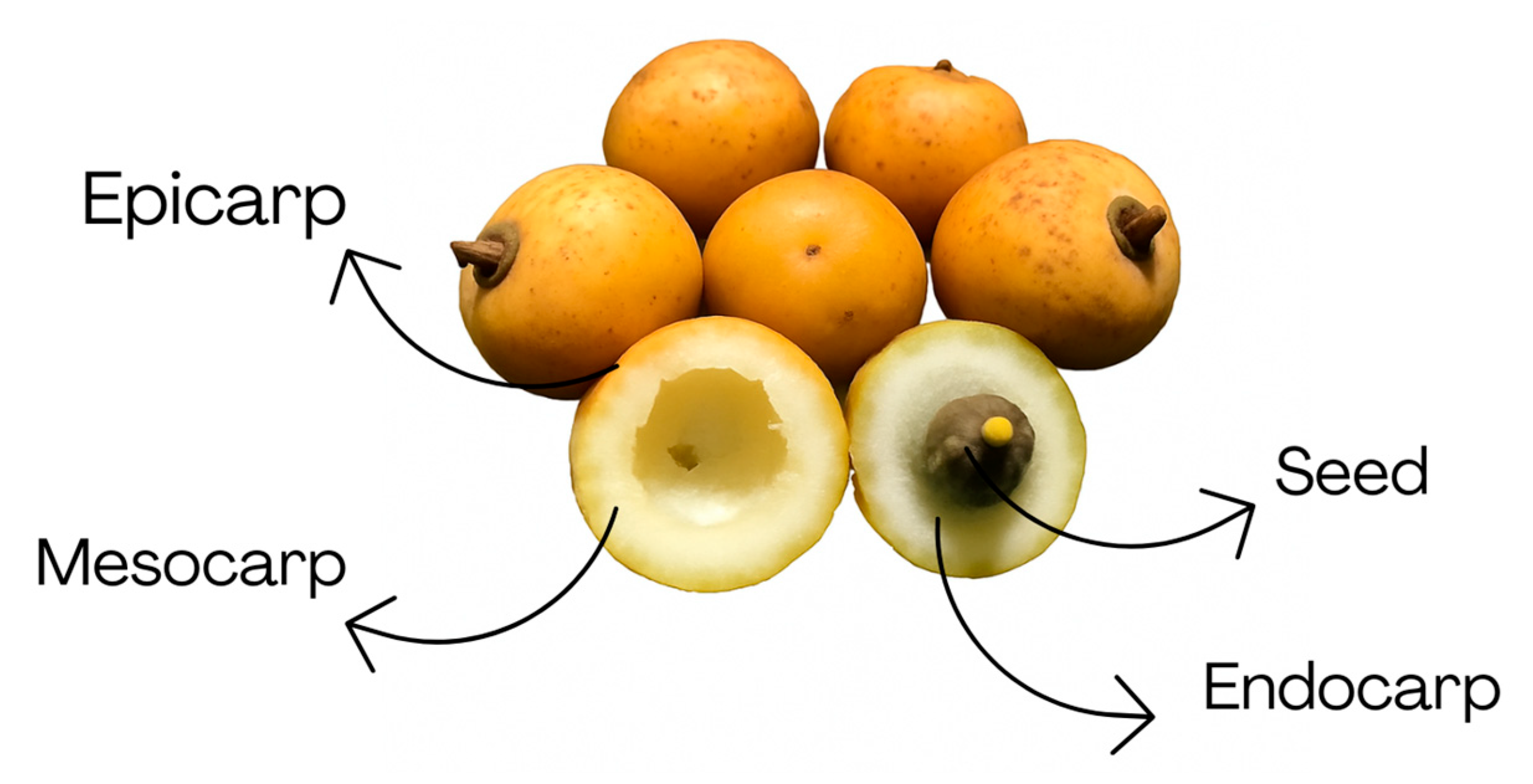
| Plant Part | Study | Potential Applications | Reference |
|---|---|---|---|
| Fruit | Effect of an edible coating with juá mucilage, incorporated with juá phenolic extract and juá mucilage with gum arabic, on the physicochemical quality, bioactive compounds, and antioxidant activity of freshly cut pineapple | Food coating | [20] |
| Leaf and bark | Chemical composition of the aqueous extracts from the leaves and stem bark of Ziziphus joazeiro, as well as the antibacterial action of the extracts alone and in combination with conventional antibiotics to assess their potential as antibiotic-modifying agents | Antibiotic-modifying agents | [4] |
| Leaf | Chemical profile of the hydroalcoholic extract from Ziziphus joazeiro Mart. leaves and its antioxidant, antiparasitic (Trypanosoma cruzi and Leishmania), and antibiotic (bacteria and fungi) activity, either alone or in combination with currently used conventional antibiotics | Hydroalcoholic extract | [22] |
| Bark and leaf | Antioxidant and antimicrobial activity of ethanolic extracts from Ziziphus joazeiro Mart., through a comparative investigation between bark and leaves | Antioxidant and antimicrobial ethanolic extracts | [23] |
| Stem bar | Description of the corrosion-inhibiting properties of the aqueous extract from the stem bark of Ziziphus joazeiro | Corrosion-inhibiting | [7] |
| Flowers | Analysis of the reproductive phenology, floral biology, and pollination system of Ziziphus joazeiro | Nectar with high sugar concentration | [18] |
| Leaf | The synthesis and optimization of silver nanoparticle preparation through the reduction of silver nitrate by the action of the aqueous extract of Ziziphus joazeiro, demonstrating effective antimicrobial activity against Staphylococcus aureus and Escherichia coli | Efficacy against Gram-positive and Gram-negative bacteria | [24] |
| Bark and leaf | Evaluation of the action of the aqueous extract from the bark and leaves of Ziziphus joazeiro in the eradication of bacterial and fungal biofilms, comparing these effects with those of the stem bark extract as well as standard conventional drugs | Bacterial and fungal biofilms | [25] |
| Leaf and bark | Allelopathic potential of leaf, bark, and root extracts of Ziziphus joazeiro on the germination and development of the weed species Calotropis procera and Cyperus echinatus | Control of the weed C. echinatus and possibly other monocotyledonous species | [21] |
| Seed | To evaluate the allelopathic activity of seed extract from Ziziphus joazeiro Mart. on the germination of lettuce (Lactuca sativa L.) seeds | Allelopathic potential of seeds from Ziziphus joazeiro Mart | [25] |
| Bark | Study of a natural alternative from Ziziphus joazeiro bark for the adsorption of indigo blue textile dye | Treatment of textile effluents containing indigo blue dye | [26] |
| Stem bark | Antimicrobial and antifungal activity of crude stem extract from juá for traditional use in combating mycoses | Combating myco | [27] |
| Compounds | Plant Part | Identification Method | Reference |
|---|---|---|---|
| Saponins | Bark | In vitro anthelmintic activity | [37] |
| Saponins | Bark | Spectrophotometry | [26] |
| Betulinic acid | Bark | Micro ondas | [38] |
| Betulinic acid, ursólico e alfitólico, ácido 7 beta-(4-hidroxibenzoiloxi)-betulínico, ácido 7 beta-(4-hidroxi-3′-metoxibenzoiloxi)-betulínico e ácido 27-(4-hidroxi-3′-metoxibenzoiloxi)-betulínico | Bark | NMR spectroscopy and Mass spectrometry | [39] |
| Caffeic acid p-Coumaric acid Ferulic acid Cinnamic acid Naringenin Pinocembrin Apigenin | Leaves and bark | HPLC/DAD | [40] |
| Saponins | Bark | Vanillin–sulfuric acid | [41] |
| Guanidinosuccinic acid Aconitic acid Malic acid Citric acid Isospinosin Spinosin Ziziphursolic acid Protocatechuic acid Chalconaringenin-di-C-hexoside Betulonic acid + OH Jujuboside B Jujubasaponin III Ziziphin Ziziphus saponin I | Stem bark | UPLC-QTOF-MS/MS | [42] |
| Mauritine-L Sanjoinine-F Sativanine-C Sanjoinine-A Numularine-B, O, and Xylopyrine B Paliurine-D and C Jubanine-A and B | Stem bark | UHPLC-ESI-Orbitrap-HR-MS | [43] |
| Jujuboside B Medicoside C 3-O-[β-d-Glucopiranosil (1→2)α-l-arabinopiranosil]-20-O-α-l-ramnopiranosil-jujubogenina | Stem bark | Dionex UHPLC liquid chromatography | [10] |
| Saponin None C-flavone glycosides Myricetin-0-glucoside Rutin Quercetin-0-hexoside Quercetin-robnoside Ramnazin-3-0-rutinoside Ramnazin-hexoside Dihydroxybenzoic acid pentoside None | Leaves and stem bark | UPLC-MS-ESI-QTOF | [44] |
| Ellagic acid | Fruits | HPLC | [11] |
| Parameters | Quantity (%) | References |
|---|---|---|
| Water content | 79.01 | [5] |
| Protein | 2.13 | [59] |
| Lipids | 1.15 | [59] |
| Carbohydrates | 17.59 | [5] |
| Ashes | 0.93 | [60] |
| Total soluble solids (°Brix) | 18.98 | [5] |
| Acidity titratable (%citric acid) | 0.23 | [61] |
| pH | 5.3 | [5] |
| Water activity (Aw) | 0.98 | [61] |
| Reducing sugars (% in glucose) | 12.12 | [60] |
Disclaimer/Publisher’s Note: The statements, opinions and data contained in all publications are solely those of the individual author(s) and contributor(s) and not of MDPI and/or the editor(s). MDPI and/or the editor(s) disclaim responsibility for any injury to people or property resulting from any ideas, methods, instructions or products referred to in the content. |
© 2025 by the authors. Licensee MDPI, Basel, Switzerland. This article is an open access article distributed under the terms and conditions of the Creative Commons Attribution (CC BY) license (https://creativecommons.org/licenses/by/4.0/).
Share and Cite
Andrade, F.S.; Figueirêdo, R.M.F.d.; Queiroz, A.J.d.M.; Albuquerque Junior, N.d.M.; Silva, A.P.d.F.; Amadeu, L.T.S.; Carvalho, R.d.O.; Silva, W.P.d.; Saraiva, M.M.T.; Hamawand, I. General Aspects and Applications of Juazeiro (Ziziphus joazeiro Mart.): Bioactive Compounds, Antioxidant Activity, and Antimicrobial Potential. Processes 2025, 13, 3352. https://doi.org/10.3390/pr13103352
Andrade FS, Figueirêdo RMFd, Queiroz AJdM, Albuquerque Junior NdM, Silva APdF, Amadeu LTS, Carvalho RdO, Silva WPd, Saraiva MMT, Hamawand I. General Aspects and Applications of Juazeiro (Ziziphus joazeiro Mart.): Bioactive Compounds, Antioxidant Activity, and Antimicrobial Potential. Processes. 2025; 13(10):3352. https://doi.org/10.3390/pr13103352
Chicago/Turabian StyleAndrade, Fabrícia Santos, Rossana Maria Feitosa de Figueirêdo, Alexandre José de Melo Queiroz, Nailton de Macedo Albuquerque Junior, Aline Priscila de França Silva, Lumara Tatiely Santos Amadeu, Raniza de Oliveira Carvalho, Wilton Pereira da Silva, Maria Monique Tavares Saraiva, and Ihsan Hamawand. 2025. "General Aspects and Applications of Juazeiro (Ziziphus joazeiro Mart.): Bioactive Compounds, Antioxidant Activity, and Antimicrobial Potential" Processes 13, no. 10: 3352. https://doi.org/10.3390/pr13103352
APA StyleAndrade, F. S., Figueirêdo, R. M. F. d., Queiroz, A. J. d. M., Albuquerque Junior, N. d. M., Silva, A. P. d. F., Amadeu, L. T. S., Carvalho, R. d. O., Silva, W. P. d., Saraiva, M. M. T., & Hamawand, I. (2025). General Aspects and Applications of Juazeiro (Ziziphus joazeiro Mart.): Bioactive Compounds, Antioxidant Activity, and Antimicrobial Potential. Processes, 13(10), 3352. https://doi.org/10.3390/pr13103352









